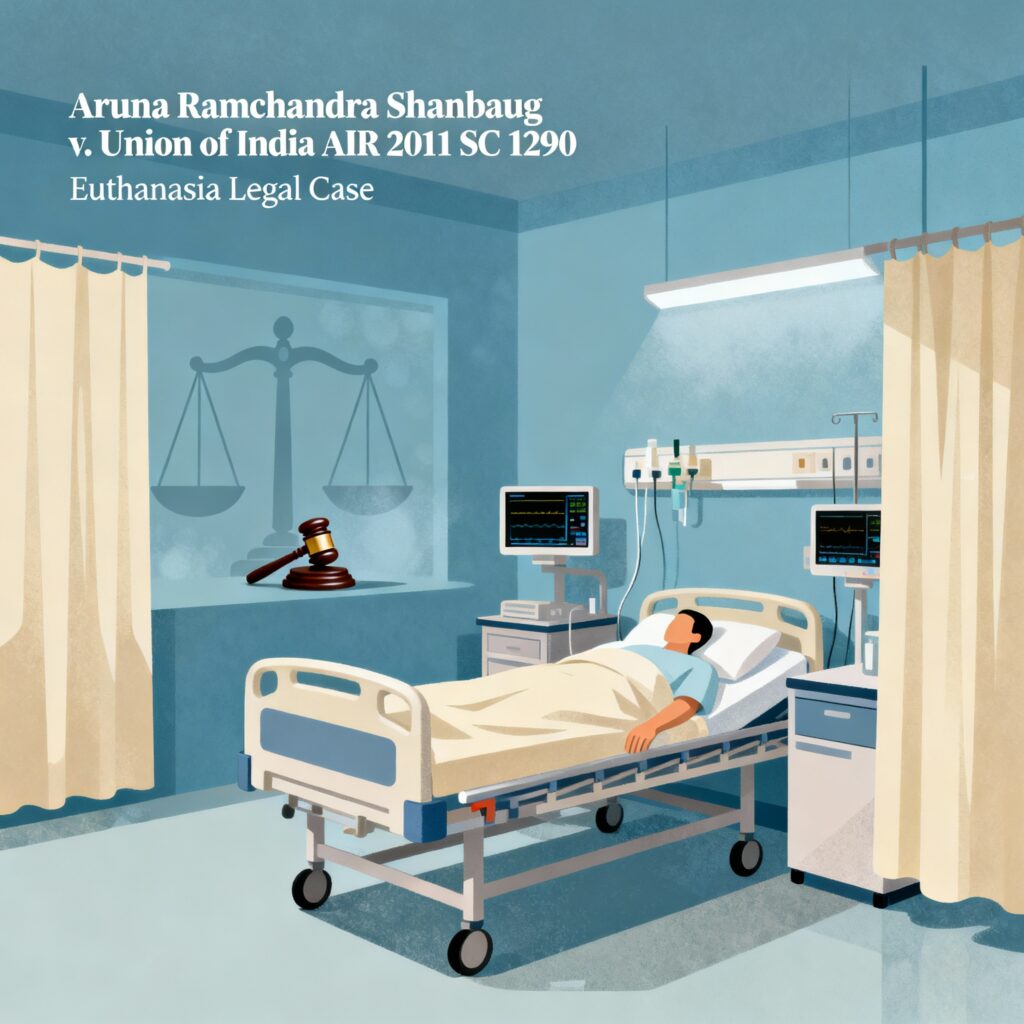Published On: October 7th 2025
Authored By: Shreshtha
Guru Gobind Singh Indraprastha University
Introduction
Euthanasia is substantially associated with people with terminal illness or who have come incapacitated and don’t want to go through the rest of their life suffering. An oppressively hindered or terminally ill person should have the right to choose to live or die. The right to choose to live or die should not be a right allocated for bodied individualities of sound mind but to all mortal beings. From the moment of his birth, a person is clothed with introductory mortal rights. Right to life is one of the introductory as well as abecedarian right without which all rights cannot be enjoyed. Right to life means a mortal being has an essential right to live, particularly that similar mortal being has the right not to be killed by another mortal being. Every grown-up of sound mind has a right to determine what should be done with his/ her person. It’s unlawful to administer treatment on an grown-up who’s conscious and of sound mind, without his concurrence. Cases with endless Vegetative State( PVS) and no hope of enhancement can not make opinions about treatment to be given to them. It’s eventually for the Court to decide, as” PARENS PATRIAE” 1 meaning thereby” Parent of the Nation” as to what’s in the stylish interest of the case. An incorrect decision not to terminate results in conservation of the status quo; the possibility of posterior developments similar as advancements in medical wisdom, the discovery of new substantiation regarding the case’s intent, changes in the law, or simply the unanticipated death of the case despite the administration of life- sustaining treatment, at least produce the eventuality that a wrong decision will ultimately be corrected or its impact eased. Every human being solicitations to live and enjoy the life till he dies. But occasionally a mortal being wishes to end his life in the manner he chooses. To end one’s life in an unnatural way constitutes sign of abnormality. When a person ends his life by his own act we call it “ SUICIDE ” but to end a person’s life by others on the request of the departed, is called “ EUTHANASIA ” or “ Mercy Killing ”.
Meaning of “Euthanasia”
Euthanasia’ is a Greek word which is a combination of two words” EU” good or well and” THANATOS” death or’ to die well.’ therefore,’ Euthanasia’ is defined as the’ Termination of mortal life by effortless means for the purpose of ending physical suffering. occasionally, euthanasia is also defined as killing a person rather than ending the life of a person who’s suffering from some terminal illness, also called as’ Mercy Killing’ or’ Killing in the name of Compassion2.
Mercy killing is the deliberate product of death of a mortal being especially in cases where it’s regarded that death would be a preferable volition to the painful actuality. In today’s world, Mercy Killing is primarily limited to the acts of doctors endeavouring to relieve their cases of the excruciating pain they’re passing and though these doctors, if given a choice would not help in the killing of a case, they see no feasible volition. still, the conception of Mercy Killing has widened due to the fact that ultramodern technology can actually protract life and therefore, elision of an act which can protract life, is also considered a part of mercy killing.3
It’s essential to determine the difference, if there’s any, between Euthanasia and suicide. According to Durkheim, there’s hardly any difference between the two because; he described them as “ death resulting directly or indirectly from a positive or negative act of the victim himself, which he knows will produce this result”. As it can be seen, the internal condition of the case has not been regard into this description and therefore, the two can be compared. It’s a well known fact that suicide across various religions is considered to be extremely contemptuous.
The Indian courts have taken a more realistic view of the same and the difference was distinguished by Justice Lodha as,
“ Suicide by its veritably nature is an act of self- killing or self- destruction, an act of terminating one’s own life and without the aid or backing of any other mortal agency. Euthanasia or mercy killing on the other hand means and implies the intervention of other mortal agency to end the life. Mercy killing therefore is not suicide and an attempt therefore Mercy Killing is not covered by the provisions of Section 3094. The two concepts are both factually and fairly distinct. Euthanasia or Mercy Killing is nothing but homicide whatever the circumstances in which it’s affected.”
The terms Euthanasia and supported suicide are generally used synonymously. They’re still two different things. One way to distinguish them is to look at the last act – The act without which death would not do. Using this distinction, if a third party performs the last act that designedly causes a case’s death, it’s Euthanasia. On the other hand, if the person who dies performs the last act, supported suicide has taken place.
Classification of Euthanasia
Euthanasia’ is the termination of an ailing person’s life in order to relieve him of the suffering. In utmost cases, euthanasia is carried out because the person seeks relief and asks for it, but there are cases called euthanasia where a person can not make such a request. Astronomically, Euthanasia may be classified according to whether a person gives informed assent under the following heads
- Voluntary Euthanasia
- Non-Voluntary Euthanasia
- Involuntary Euthanasia
(A) Voluntary Euthanasia
When euthanasia is practiced with the expressed desire and consent of the patient it is called Voluntary Euthanasia. It is primarily concerned with the right to choice of the terminally ill patient who decides to end his or her life, choice which serves his/her best interest and also that of everyone else connected to him. This includes cases of:
– Seeking assistance for dying
– Refusing heavy medical treatment
– Asking for medical treatment to be stopped or life support equipment to be switched off
– Refusal to eat or drink or deliberate fasting.
(B) Non- Voluntary Euthanasia
It refers to ending the life of a person who is not mentally competent to make an informed decision about dying, such as a comatose patient. The case may happen in case of patients who have not addressed their wish of dying in their Wills or given advance indications about it. Instance can be enumerated, like severe cases of accident where the patient loses consciousness and goes into coma. In these cases, it is often the family members, who make the ultimate decision. The person cannot make a decision or cannot make their wishes known. This includes cases where:
– The person is in a coma
– The person is too young (e.g. a young baby)
– The person is absent-minded
– The person is mentally challenged
(C) Involuntary Euthanasia
Involuntary euthanasia5 is euthanasia against someone’s wish and is often considered as murder. This kind of euthanasia is usually considered wrong by both sides hence rarely discussed. In this case, the patient has capacity to decide and consent, but does not choose death, and the same is administered. It is quite unethical and sounds barbaric. During World War II, the Nazi Germany conducted such deaths in gas chambers involving people who were physically incapable or mentally retarded. Euthanasia can be further classified in two regarding its manner. They are Active Euthanasia and Passive Euthanasia.
1.) Active Euthanasia
It involves painlessly putting individuals to death for merciful reasons. A doctor administers lethal dose of medication to a patient. Active euthanasia involves the use of lethal substances and it is where the controversy begins. A person cannot himself cause his death but requires someone else’s help with some medication causing death. As already stated above active euthanasia is a crime all over the world except where permitted by legislation. In India active euthanasia is illegal and a crime under section 302 or at least section 304 IPC. Physician assisted suicide is a crime under section 306 IPC (abetment to suicide).
2.) Passive Euthanasia
Euthanasia is passive when death is caused by turning off the life supporting systems. Withdrawing life supporting devices from a terminally ill patient which leads eventually to death in normal course is a recognized norm. In “passive euthanasia” the doctors are not actively killing anyone; they are simply not saving him6. Passive euthanasia requires the withholding of common treatments, such as antibiotics, necessary for the continuance of life. Passive euthanasia is described when the patient dies because the medical professionals refrain from doing something necessary to keep the patient alive, such as:
– Switch off life-support machines
– Disconnect a feeding tube
– Not to carry out a life-extending operation
– Not to give life-extending drugs
Effective therapeutic treatment is possible with these patients. Compassionate counselling and assistance, which are provided in hospitals as well as psychological care, can prevent a patient to chose death. In rarest of the rare cases where we don’t have any medical treatment and the patient is experiencing lot of pain and he/she does not want to live any more, mercy killing could be permitted. This is so because why should a person who any how is going to die be not allowed to end his life. But it should be permitted only on his consent.
However, I’m of the view that euthanasia should be accepted as Human right, because if the individual is not able to live with human dignity, the life has no value. Hence, euthanasia should be permitted subject to legal framework supported by public opinion. Since, the Medical Science also support the Mercy killing, thus it should be permitted. By legalizing the euthanasia, the natural death of the individual who is suffering from irrecoverable disease can be made easier.
References
- https://doi.org/10.1002/9781118517383.wbeccj351
- Angkina Saikia, Euthanasia ‘Is It Right To Kill’ or ‘Right To Die’, Cr LJ 356.
- Jonathan Moreno ,arguing euthanasia : the controversy over mercy killing, Assisted Suicide and the right ‘right to die’,1995
- Sec 309 of IPC “Whoever attempts to commit suicide and does any act towards the commission of such offence shall be punished with simple imprisonment for a term which may extend To one year or with fine or with both”
- Jackson, Jennifer (2006). Ethics in medicine. Polity. p. 137
- Aruna Ramchandra Shanbaug v. Union of India, 2011(3) SCALE 298.



